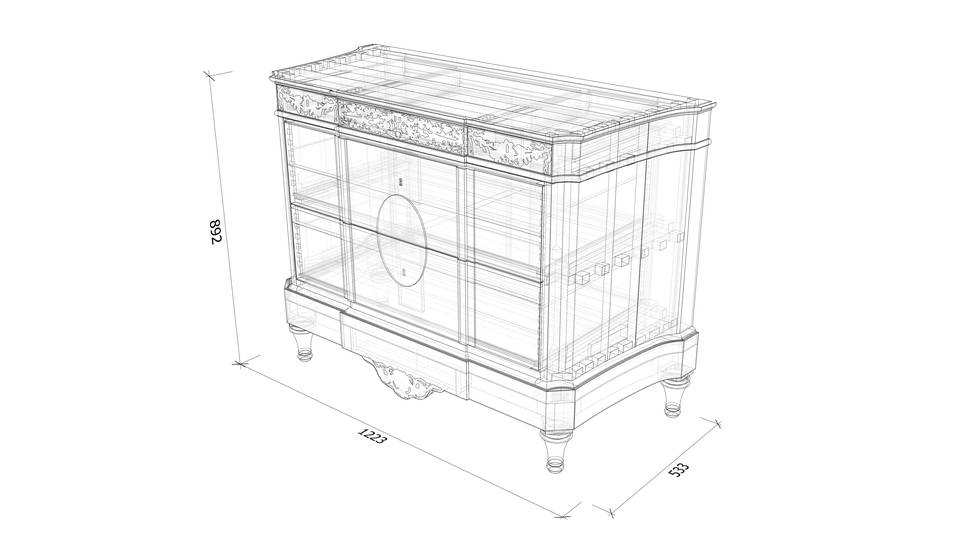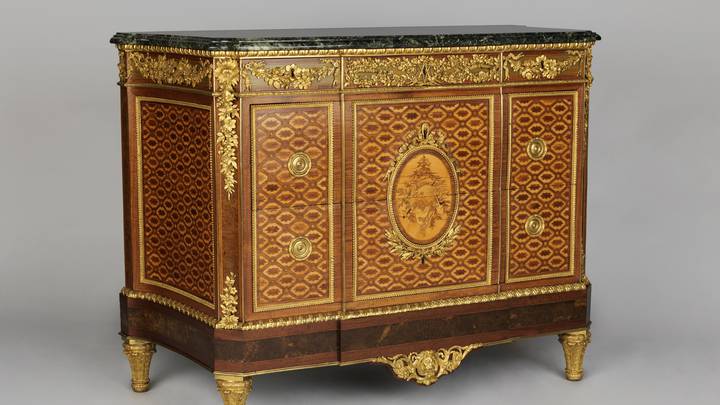Date: 1780
Maker: Cabinetwork attributed to Jean-Henri Riesener
Materials: Oak, purplewood, satiné, stained woods, burr wood, ebony or ebonised wood, box, gilt bronze, vert des Alpes marble
Measurements: 92 x 122.4 x 54.8 cm
Inv. no. F247
From 1780 Riesener appears to have adopted a new style of furniture for his royal patrons, especially those that were intended for the queen. Marie-Antoinette spent much time with her brother-in-law, the comte d’Artois (1757–1836), who showed a keen interest in interior decoration and commissioned some of the most fashionable and expensive furniture of the period.
Marie-Antoinette herself began to experiment more with her private apartments and ordered several of them to be refurbished. In 1779, the walls of her cabinet intérieur (private sitting room) were hung with new silk and Riesener delivered new case furniture the following year.
In December 1780, this chest-of-drawers was delivered to Versailles, along with a new fall-front desk. The chest-of-drawers, like the new desk, complemented the themes and décor of the room. It was veneered with a lozenge pattern, which is also referred to as a ‘trellis’ pattern, of marquetry, in a reinterpretation of a classical architectural motif that had been used in various decorative guises since the end of the 17th century. It was considered especially appropriate for royal decoration, since it had been used in the chapel at Versailles about 1710 and in the celebrated King’s Desk delivered to Louis XV by Riesener in 1769
Riesener continued to use this motif, with its sunflowers at the centre, brilliantly adapting it for all kinds of furniture, including pieces delivered to the king’s brother, the comte de Provence and his wife, and Marie-Antoinette.
Here, however, the customary larger motifs found on earlier pieces — such as vases of hardstone flowers — have been replaced with a single, delicate medallion of floral marquetry, which has been designed to complement the marquetry medallions embroidered on the wall silk. Representing a pastoral trophy, it depicts bagpipes, a shepherd’s hat and various flowers such as jasmine, roses, cornflowers and narcissi.
Marquetry was what Riesener was renowned for and this chest-of-drawers does not disappoint. It shows extraordinary levels of skill. Each lozenge comprises at least twenty-eight different pieces of wood that have been cut and laid together to form the octagonal trellis and the flower inside and the marquetry of the medallion is highly detailed and naturalistic.
Unfortunately, some of the impact of the decoration has been lost over time, because Riesener used highly coloured pieces of wood for his marquetry and this would have given the chest-of-drawers a totally different look to the one we see now.
The vibrant appearance was created through the natural hues of the woods, such as purplewood, which would have given the border framing the panels a purple aspect, and satiné, which would have given the trellis a rich deep red tone. Stained woods would also have given colour to the marquetry, for example to the flowers and the shepherd’s hat in the central trophy.
In the royal accounts, this was described as a coloured painting on a blue background. It is interesting to note that the design for the wall silk by Jacques Gondoin, the designer attached to the royal furniture administration, included a light ‘English blue’ background to each of the embroidered medallions. The entire room — walls, chairs, curtains and Riesener’s chest-of-drawers — would have been in harmony.
Apart from the marquetry, the gilt-bronze mounts of this chest-of-drawers are of exquisite beauty. It is here that Riesener has excelled himself, designing mounts that appealed to the queen’s love of flowers and which he would go on to use many times for her furniture in many different guises.
Here again the royal accounts give us further evidence, describing that they were of ‘a new model’. Made up of floral swags and garlands tied together with ribbons, the detail and naturalism are extraordinary and allow us to identify roses, pinks, convolvulus, lilies of the valley, asters and narcissi. In the centre of the frieze is a stylised representation of Marie-Antoinette’s initials: MA, which leaves us in no doubt as to whom the chest-of-drawers was intended for and was repeated by Riesener on subsequent furniture for the queen.
On the two front corners, carefully angled to allow for the decoration, more beautifully modelled gilt-bronze flowers drop from a large dahlia.
Marie-Antoinette’s evolving taste meant that she changed the décor of this room once again a few years later. In 1783 the furniture was removed and later replaced by a new set comprised of a fall-front desk, corner-cupboard and chest-of-drawers made by Riesener.
Later the same year, that too was replaced by a set of lacquer-mounted furniture, including a fall-front desk and chest-of-drawers, that Riesener provided.
For more information: Jacobsen, H. et al., Jean-Henri Riesener. Cabinetmaker to Louis XVI and Marie-Antoinette. Furniture in the Wallace Collection, Royal Collection and Waddesdon Manor, London, 2020, no. 17.

